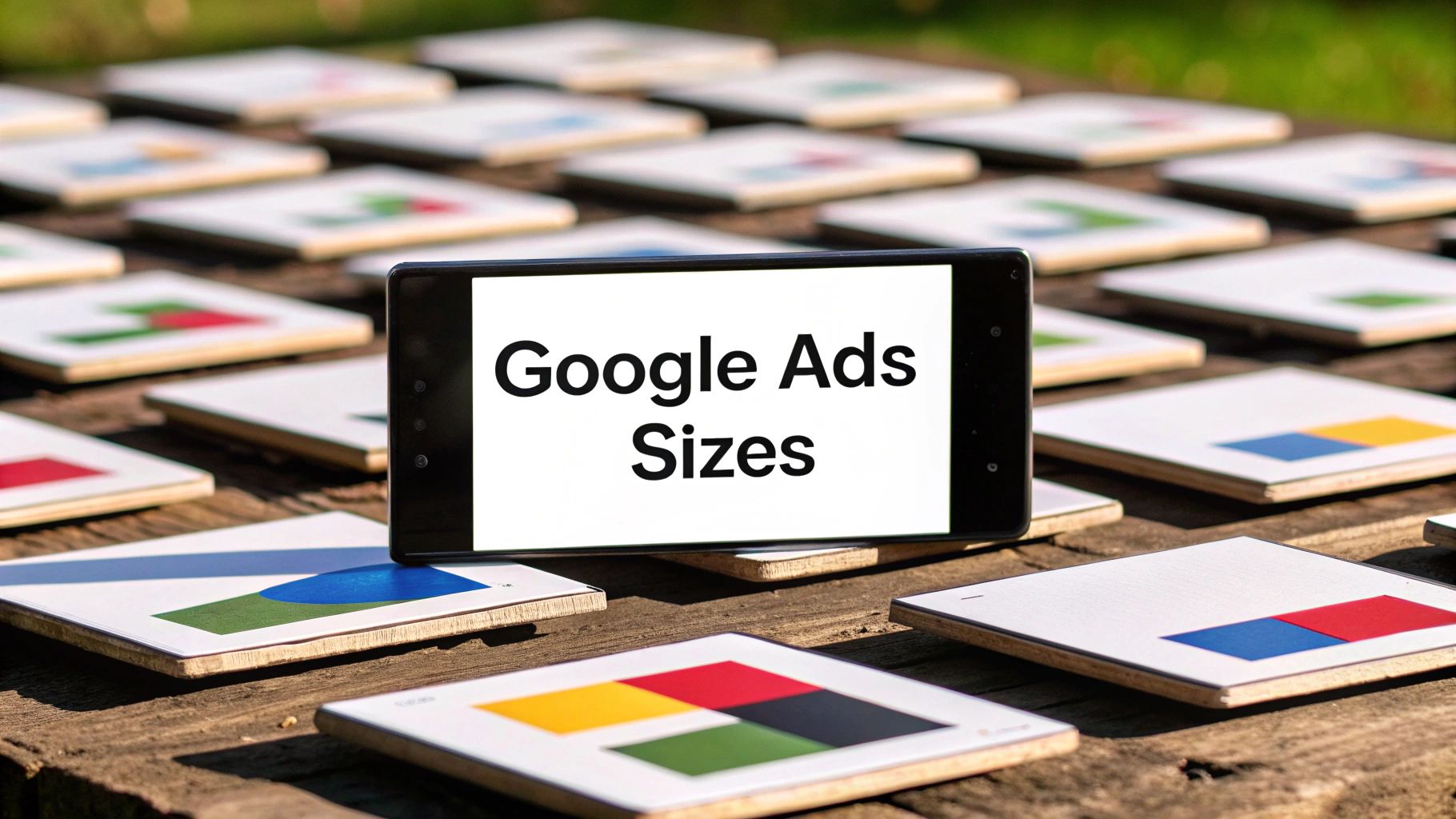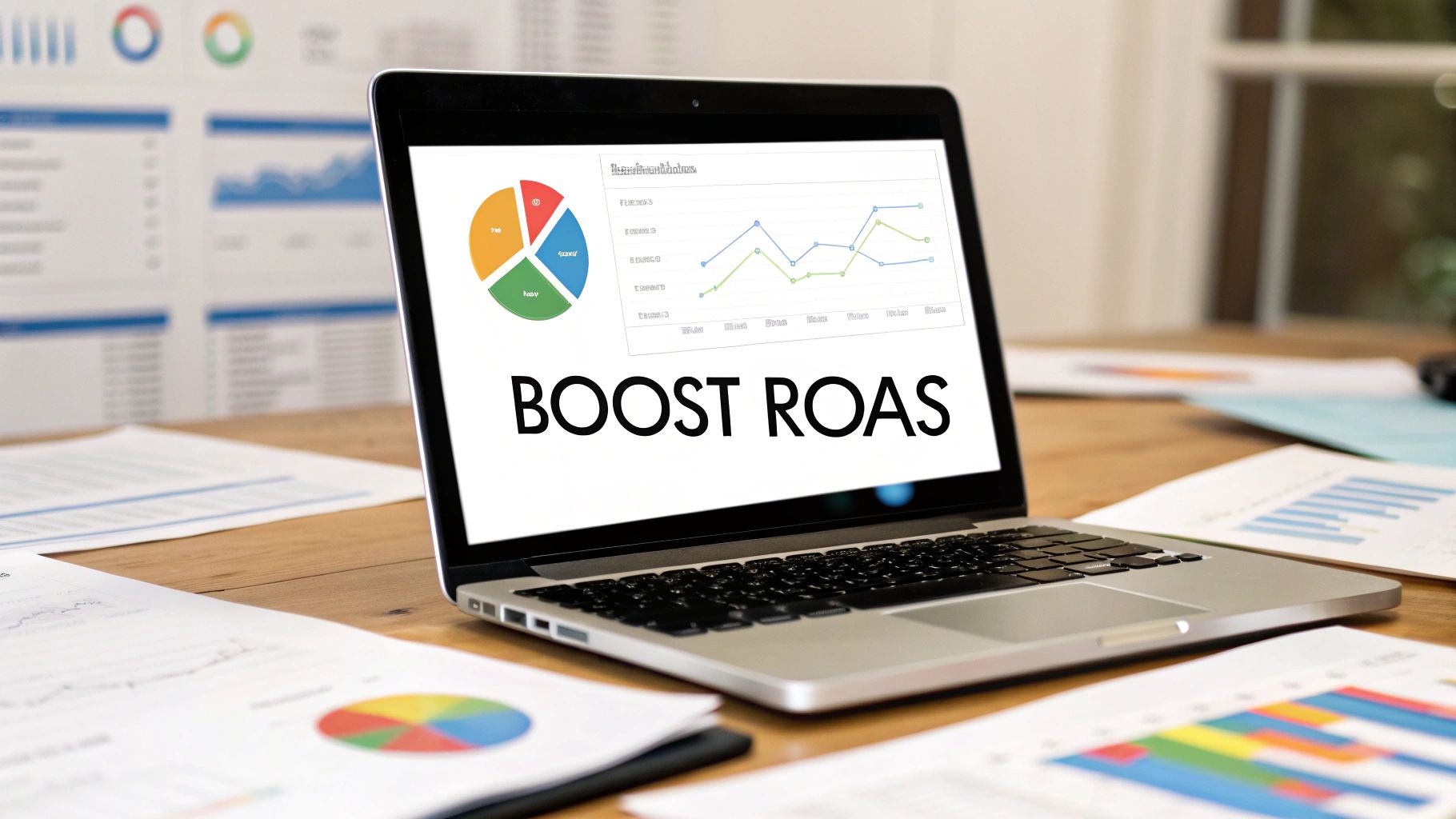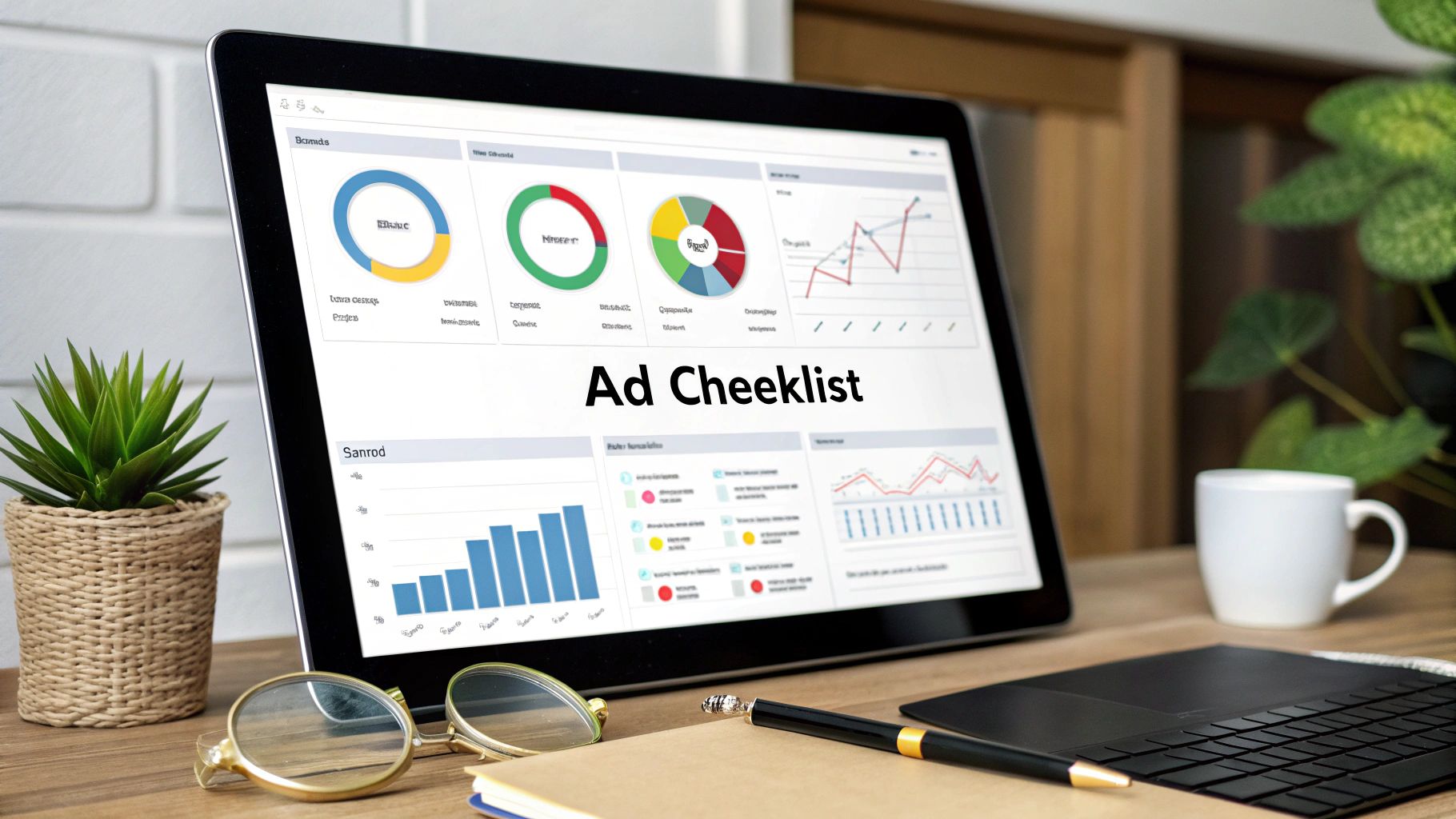Google Ads Budget Calculator | Maximize Your ROI
- Chase McGowan

- Sep 19
- 13 min read
Let's be real—most of the "Google Ads budget calculators" you find online are just glorified lead magnets for over-priced, bloated agencies. They’re built to give you a big, scary number based on fuzzy industry averages, which just so happens to justify their hefty monthly retainers.
It's a one-size-fits-all approach that's fundamentally broken. It’s like a doctor prescribing the same pill to every single patient, no matter their symptoms. These tools run on pure assumption, completely ignoring the variables that actually drive profit for your business. They are designed to benefit the agency, not you.
Why Agency Calculators Don't Work for Your Business
Relying on broad industry data is a fast track to burning through your ad budget. For instance, the global average cost per click (CPC) on Google Search is supposedly around $8.34. But that number is useless without context.
I’ve seen legal keywords go for as high as $22.75 per click, while some e-commerce terms are closer to $0.82. Any calculator that glosses over that massive difference is setting you up to fail right out of the gate. This is a classic agency tactic to get you to commit to a big spend without doing the real strategic work first.
These tools almost never ask the questions that actually matter:
What’s your real profit margin on a sale?
What’s the lifetime value (LTV) of a new customer you acquire?
What’s your absolute break-even point for getting that customer?
Without knowing this, any budget they spit out is just a shot in the dark. That number isn't designed to make you money; it's designed to make them money by getting you to spend more.
I once took over an account where a large agency had used their calculator to convince a client to spend $15,000 a month. Sure, the agency was hitting their target "cost per lead," but the client was bleeding cash because the leads were junk and never closed. We slashed the budget by 40%, zeroed in on high-intent keywords, and tripled their actual profit inside of two months. That's the difference expert attention makes.
The Consultant's Approach is Different
An experienced consultant doesn't start with industry averages; I start with your business goals. As your dedicated specialist, I work backward from your desired profit to build a budget that actually makes sense for your bottom line.
This is the key difference between hiring a dedicated Google Ads consultant and getting stuck with a bloated agency where your account is passed off to a junior employee running off a template. You get my direct expertise, not a diluted, one-size-fits-all strategy.
Instead of chasing vanity metrics like clicks and impressions, my focus is on what really moves the needle: Return on Ad Spend (ROAS) and, most importantly, profit.
It’s about building a strategic partnership, not just a vendor relationship. This way, every dollar you spend is a calculated investment toward real growth, not just an expense line to keep a big agency's lights on.
Calculate Your Budget by Working Backwards from Profit
Forget the classic (and completely flawed) question, "What can I afford to spend on ads?"
The only question that actually moves the needle is, "How much profit do I need to make?" This is where my approach as a consultant splits from the typical agency model. We don't start with a budget to burn; we start with a profit goal and reverse-engineer the path to get there.
This "profit-first" method anchors every single dollar you spend to a tangible business outcome. Instead of guessing at a daily budget, you're building a data-driven machine. This is how a real-world Google Ads budget calculator should function—by connecting spend directly to profitability.
Key Inputs for Your Profit-First Budget Calculation
Before you can build a budget that works, you need to gather the right data. It’s not about pulling a hundred different metrics; it’s about focusing on the few that truly matter. Here's a breakdown of the essential inputs and why they're so critical.
Gathering these numbers is the non-negotiable first step. It shifts the conversation from "spending money" to "investing in growth."
First, Define Your True Business Goals
Let's get specific. What does success actually look like in dollars and cents? Stop thinking about clicks or impressions for a moment and focus on the numbers that hit your bank account.
What is your target revenue from this campaign? More importantly, what is your profit margin on that revenue?
Knowing you make $50 profit on a $200 sale is infinitely more powerful than just knowing the sale price. That single number is the foundation of a budget that can actually scale.
Next, Calculate Your Break-Even Point
Once you know your profit margin, the next step is to figure out your break-even Return on Ad Spend (ROAS). This isn't your goal ROAS; it's the absolute floor—the minimum you need to make back just to cover your ad costs without losing a dime.
Here’s the simple formula I use with every single client:
Break-Even ROAS = 1 / Your Profit Margin (%)
Let's use an example. If your profit margin is 25% (or 0.25), your break-even ROAS is 1 / 0.25, which equals 4x. This means for every $1 you spend on ads, you have to generate at least $4 in revenue just to break even.
Anything above that 4x is pure profit.
This is the starting point for mapping out everything else, from the clicks you need to the revenue you can expect, as shown below.
This process ensures your budget isn't just some arbitrary number you pulled out of thin air. It’s a direct reflection of the inputs required to hit your goals.
Finally, Connect Ad Spend to Your Profit Target
Now we can finally build the budget.
Let’s say your goal is to generate $5,000 in profit this month. Using the 25% profit margin from our example, you know you'll need to generate $20,000 in total revenue ($5,000 / 0.25).
Since your break-even ROAS is 4x, you can spend up to $5,000 on ads ($20,000 revenue / 4x ROAS) to hit that revenue target and break even. To make a profit, your ROAS needs to be higher than 4x, or you need to spend less than $5,000 to achieve the $20,000 revenue.
This reverse-engineering process gives you a systematic, data-driven way to plan your ad spend. You move completely away from guesswork. This method prevents the most common and costly mistakes I see, like underfunding winning campaigns or burning cash with no guaranteed return. If you'd like to dive deeper, you can learn more about this strategic approach and its benefits for campaign planning.
How to Estimate Your Key Performance Metrics
A budget built on profit goals is a great start, but it's only half the story. The entire calculation hinges on two metrics you absolutely have to get right: your estimated Cost Per Click (CPC) and your projected Conversion Rate (CVR).
Without realistic numbers here, even the most sophisticated profit-first formula is just a shot in the dark.
This is where so many businesses get stuck, especially if they’re launching new campaigns and flying blind without any historical data. Too many agencies just plug in vague industry averages, which is not only lazy but dangerously misleading. As a consultant, my process is way more granular because your success—and my reputation—depends on it.
Finding a Realistic Cost Per Click
Forget generic industry benchmarks. Your actual CPC will come down to the specific keywords you target, your geographic location, and just how bloody competitive your market is. The name of the game is to get as specific as possible, right from day one.
I always start with Google's own free tool, the Keyword Planner. It’s not perfect, but it’s the most direct data source you’ve got.
Here’s how I use it to pull out some realistic numbers:
Focus on High-Intent Keywords: I skip the broad, expensive stuff like "plumbing services." Instead, I dig for long-tail keywords that scream immediate need, like "emergency plumber for leaking pipe near me." Sure, they might cost more per click, but they convert at a much higher clip.
Analyze the "Top of Page Bid" Range: Keyword Planner gives you a low and high range for what it costs to show up at the top. I always, always tell clients to budget for the higher end of that range. It’s so much better to be conservative and have a budget surplus than to be underfunded and completely invisible.
Filter by Location: A keyword that costs $5 in a small town might cost $25 in a major city. I always narrow the forecast down to the specific cities or regions we're actually targeting. This alone makes the CPC estimate infinitely more accurate.
This hands-on research is non-negotiable. When I kick off a new campaign, I often set the initial manual bids just a hair above that estimated high range. Why? To gather data quickly. After the first 30-60 days, we’ll have real-world performance data to start making smarter decisions. This is a level of active, hands-on management you just don't get from a big agency that passes your account off to a junior manager.
Establishing a Conservative Conversion Rate
Your conversion rate is simply the percentage of clicks that actually turn into a lead or a sale. If you have any existing data—maybe from organic search or social media—that’s your best starting point. If your website already converts 2% of organic visitors, it’s pretty reasonable to assume a similar rate for paid traffic, at least to start.
But what if you have no data at all? Start conservatively. I typically project a 1% to 2% CVR for a brand new search campaign. This keeps expectations in check and prevents the whole budget model from being built on a house of cards. When you’re estimating your Google Ads performance, it’s essential to understand the core concept of Pay-Per-Click (PPC) advertising.
Your initial estimates are just a baseline, not the final word. The goal is to get the campaign live with a data-informed budget, then optimize relentlessly based on what the real-world results are telling you. For a deeper look, check out this consultant's guide to ad performance metrics that breaks down exactly what to track.
A Practical Walkthrough of Budgeting for a Service Business
Theory is one thing, but let's get our hands dirty. We're going to map out a Google Ads budget from the ground up for a fictional local business—we'll call it "Elite HVAC Pros"—to show you exactly how this profit-first method works in the real world.
This isn't just an academic exercise. It's the kind of practical, results-driven planning that demystifies the entire process and gives you a clear roadmap. It also perfectly highlights why a consultant's detailed approach gets results that generic agency calculators simply can't touch.
Setting the Stage for Elite HVAC Pros
First, we need to know our numbers. After a deep dive into the business's finances, the owner has a solid grasp on these key metrics:
Desired Monthly Profit: The goal is to add $4,000 in pure profit each month directly from Google Ads.
Average Job Value: Each new customer brings in $500 in revenue.
Profit Margin: After all costs—parts, labor, overhead—the business pockets 20% of that revenue.
With a 20% profit margin, our Break-Even ROAS is 5x (1 / 0.20). This is our baseline. It means for every $1 we put into ads, we must get $5 back in revenue just to cover our costs. Anything above that 5x return is pure profit.
This is the critical foundation a specialized consultant builds upon, a step often glossed over by agencies just looking to spend whatever budget you give them.
From Profit Goal to Ad Budget
Okay, now we work backward from the profit goal. It's simpler than it sounds.
To hit that $4,000 profit target with a 20% margin, Elite HVAC Pros needs to generate $20,000 in new revenue ($4,000 / 0.20).
Since each job is worth $500, that means they need to land 40 new customers ($20,000 / $500). Simple enough.
Next, we bring in our estimated campaign performance. Based on some initial research (like we covered in the last section), we’ll start with a conservative Conversion Rate of 4% and an estimated Cost Per Click (CPC) of $10.00.
To get those 40 customers with a 4% conversion rate, our campaign will need to generate 1,000 clicks (40 conversions / 0.04).
The Final Calculation:With a target of 1,000 clicks at an estimated $10.00 CPC, the total required monthly Google Ads budget is $10,000 (1,000 clicks x $10 CPC). This shakes out to a daily budget of about $333.
See the difference? This is a specific, actionable number tied directly to real-world business goals. An agency calculator might have spat out a generic "industry average" spend, completely disconnected from the metrics that actually matter. For service companies, mastering Google Ads for local business is all about this kind of precision, not just making broad estimates and hoping for the best.
Optimizing Your Budget for Long-Term Growth
Figuring out your starting budget is just getting to the starting line. The real wins in Google Ads come from relentless, intelligent optimization—something that big, cookie-cutter agencies often gloss over because it demands active, expert attention.
Your initial numbers are really just an educated guess. The hard work kicks in once the real-world data starts flowing.
This isn’t about running a short-term campaign and crossing your fingers. It's about building a sustainable, long-term asset for your business. That means constantly checking your actual performance against those early estimates and knowing exactly when—and how—to make strategic shifts. A budget that never changes is a budget that's destined to fail.
From Initial Spend to Profitable Scaling
My framework for scaling campaigns profitably is dead simple: re-invest your returns to accelerate growth.
Once a campaign is hitting its target ROAS and spitting out profit, that extra cash shouldn't just get absorbed into your general revenue. The single smartest thing you can do is feed it right back into the campaign.
This creates a powerful compounding effect. A small initial win can be used to fund a slightly larger budget. That, in turn, generates more data and even better profits, which then funds even more growth. This is how I methodically take an account from a few hundred dollars a day to a major revenue engine without taking on huge financial risks.
To get the bigger picture right, mastering effective marketing budget planning strategies is a must for any kind of sustainable success.
Adapting Your Strategy Across Markets
As your business grows, you'll probably look at expanding into new regions or even different countries. This is another area where a hands-on, specialized approach is absolutely critical.
Performance can swing wildly from one location to another. You’re dealing with different levels of competition, local search habits, and even currency values. An agency running a generic playbook will get crushed here.
A sophisticated Google Ads budget calculator can help, especially when it accounts for exchange rates. This lets you accurately plan and optimize your spend across diverse international markets. With detailed insights into cost per acquisition (CPA) and overall return on investment (ROI), you can measure a campaign’s real efficiency far beyond just tracking clicks.
I had a client whose campaigns were absolutely killing it in the US but falling completely flat in Canada. A typical agency would have just panicked and cut the Canadian budget. We did the opposite. I dove into the data, found key differences in the search terms people were using, and tweaked the ad copy to connect with a Canadian audience. I turned a money-losing campaign into a profitable one.
At the end of the day, optimization is an active, ongoing process. It’s not something a junior account manager at a bloated agency can handle by checking boxes off a generic to-do list. It demands the specialized attention of an expert who is genuinely invested in your long-term success.
Your Google Ads Budget Questions Answered
When it comes to planning a Google Ads budget, I see the same questions pop up over and over. Business owners often feel like they’re flying blind, especially when big agencies give them complicated, jargon-filled answers designed to justify a hefty retainer.
My job as a consultant is to cut through that noise. I'm here to give you the straightforward, no-BS advice you won't get from an agency account manager whose main goal is to spend your budget, not protect your bottom line.
How Much Should a Small Business Budget for Google Ads?
There's no magic number, and you should be immediately skeptical of anyone who throws one out without digging into your business first. The real question isn't "how much should I spend?" but rather, "what can I realistically invest to acquire a customer and still make a profit?"
Instead of guessing, work backward from your profit goals. A smart starting point for a small business is often in the $500-$1,000 per month range. The key here is to treat this initial spend as an investment in data—you're paying to learn what works, identify winning keywords, and prove the concept before you scale.
The most successful small business clients I've ever worked with didn't start with a massive budget. They started with a smart, calculated one. Then, they scaled aggressively by reinvesting the profits. It's all about building momentum, not trying to make a huge splash on day one.
What Is a Good Cost Per Acquisition (CPA)?
A "good" CPA is completely relative to your profit margin and your customer lifetime value (LTV). An agency might tell you a $50 CPA is fantastic because it beats the industry benchmark. But if your profit on that sale is only $40, that "good" CPA is actually bankrupting you.
A true expert helps you define your target CPA based on what your business can actually afford to pay for a new customer while staying profitable.
For E-commerce: Your target CPA has to be significantly lower than your Average Order Value (AOV). No exceptions.
For Lead Generation: Your CPA should be just a fraction of the total revenue a closed lead brings in over their entire relationship with you.
A bloated agency often chases a generic CPA target to make their reports look good. A specialist focuses on hitting your profit target. There's a huge difference.
When Should I Increase My Google Ads Budget?
You increase your budget when the data proves it's a profitable move—and not a second sooner. So many businesses make the classic mistake of throwing more money at a campaign that isn't working, hoping it will magically fix the problem. That's just lighting cash on fire.
The right time to scale is when your campaign is consistently hitting or, even better, exceeding your target Return on Ad Spend (ROAS). If your break-even point is a 4x ROAS and you're consistently pulling in a 6x ROAS, that's the green light. It's time to strategically increase your spend to capture more of that profitable traffic.
This is the fundamental difference between gambling with your ad spend and making a calculated investment.
Ready to stop guessing and start building a Google Ads budget that actually drives profit? Come Together Media LLC offers the specialized, one-on-one consulting you need to move beyond generic agency advice. Get a free, no-commitment consultation to see how a data-driven strategy can transform your results. Learn more at https://www.cometogether.media.














Comments